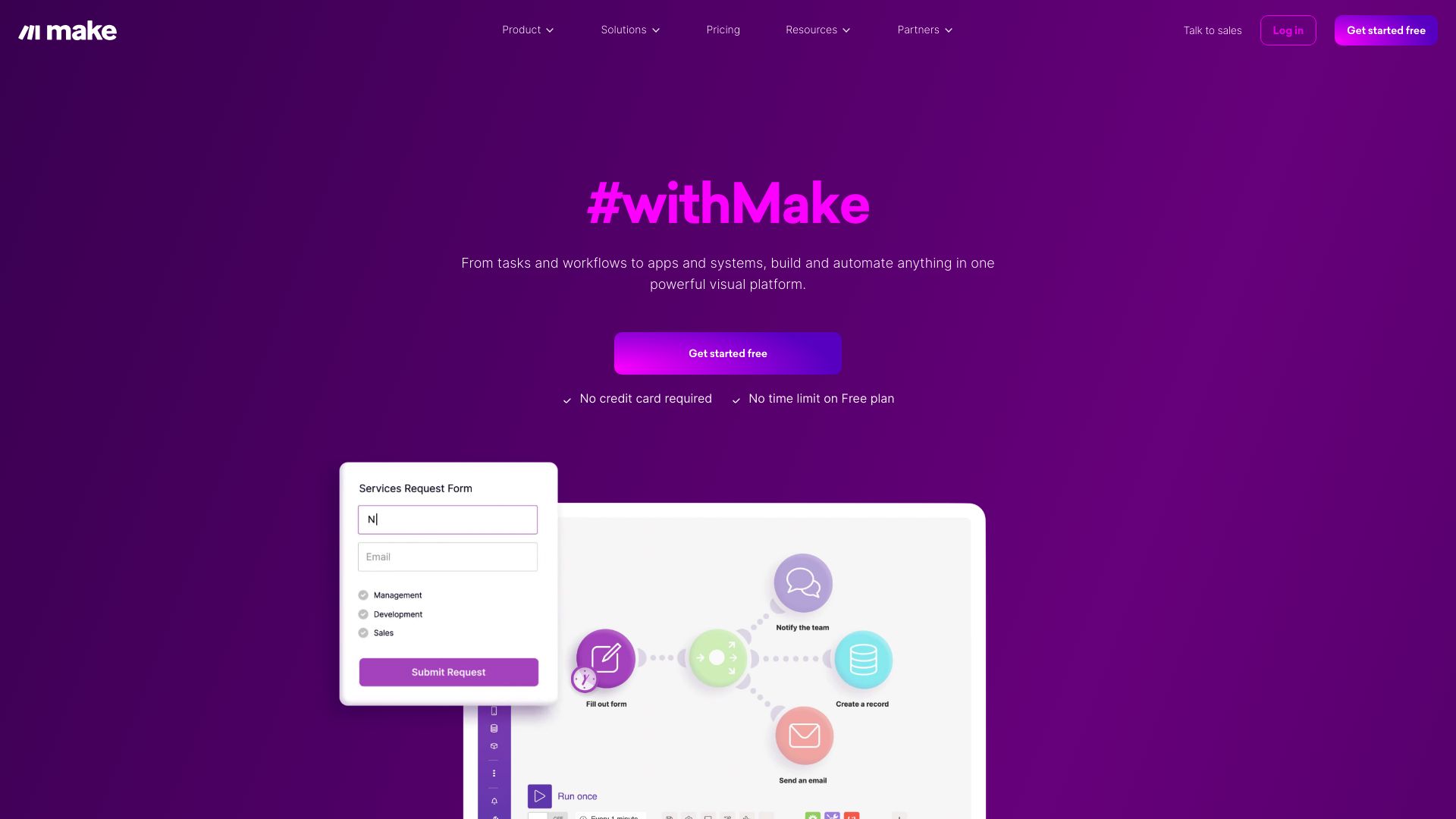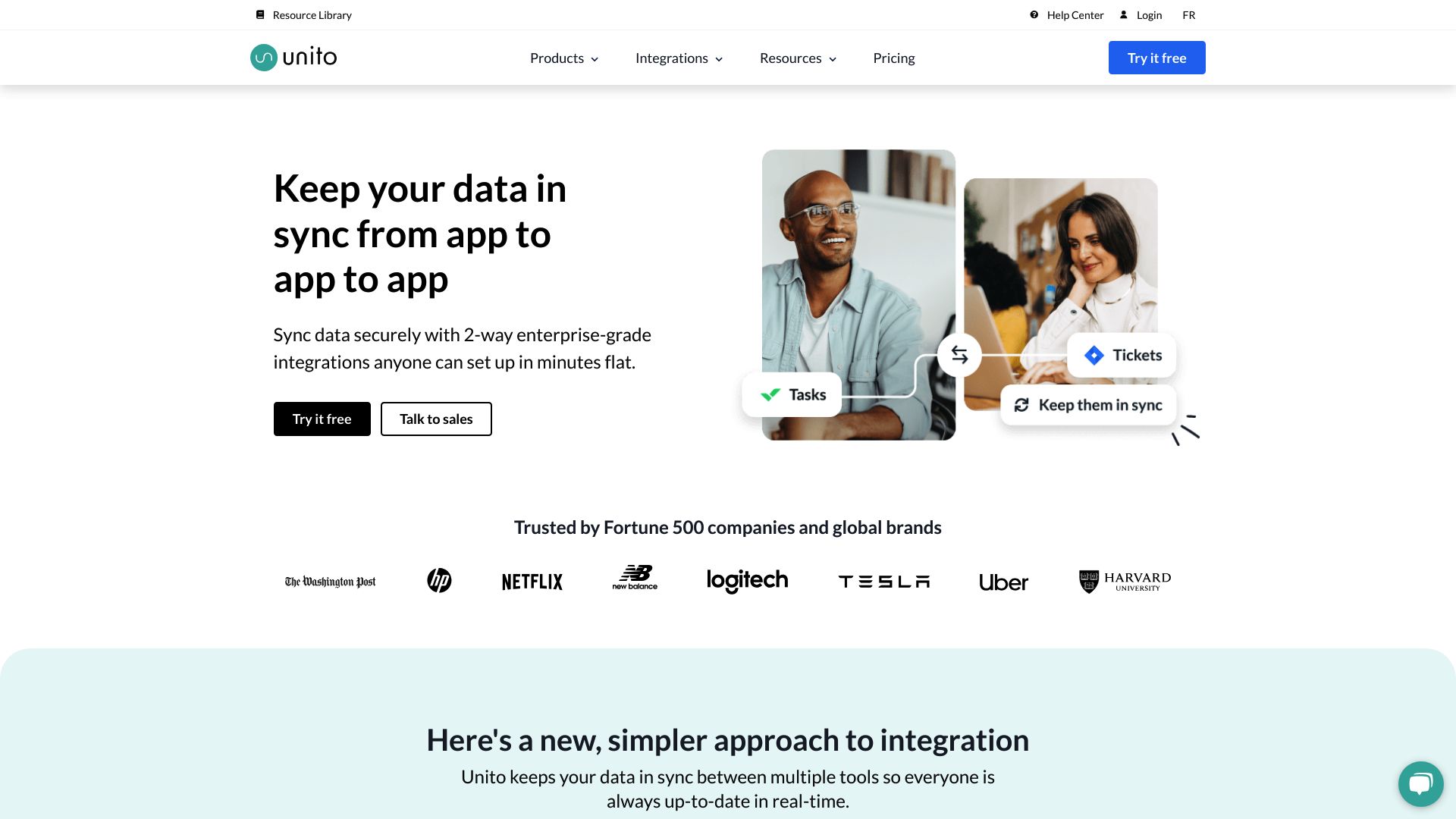Make.com vs. Unito: AI Workflow Automation Compared
Artificial intelligence reshapes how businesses operate, automate tasks, and make decisions. As organizations seek powerful yet accessible AI solutions, the market offers diverse options to meet varying needs. This comparison examines Make.com vs. Unito, and SmythOS — three platforms that approach workflow automation and AI integration differently. We’ll explore their key features, strengths, and limitations to help you determine which solution best aligns with your business goals. Whether you’re a developer seeking advanced AI capabilities, a business leader focused on scalability and security, or a non-technical user looking for no-code tools, this analysis will equip you with the insights to make an informed choice in the evolving landscape of AI-powered automation.
Make.com Overview
Make.com empowers users to automate workflows and integrate applications without coding. The platform’s visual builder enables the creation of complex scenarios connecting over 1,000 apps through a drag-and-drop interface.


Make.com caters to businesses seeking to streamline processes and boost productivity. Its no-code approach allows teams to build, test, and deploy integrations rapidly. The platform supports scheduled executions, real-time triggers, and data transformation, making it versatile for various automation needs.
Make.com empowers users to automate workflows and integrate applications without coding. The platform’s visual builder enables the creation of complex scenarios connecting over 1,000 apps through a drag-and-drop interface.
Key features include robust error handling, conditional logic, and detailed execution logs for troubleshooting. Make.com also offers team collaboration tools, allowing multiple users to work on and share scenarios. The platform scales from personal projects to enterprise-level solutions, with tiered pricing to match different needs.
While Make.com excels in workflow automation, it lacks some advanced AI capabilities. The platform does not offer hosted AI agents or specific AI-driven features like natural language processing or machine learning models. This limitation may impact users looking for more sophisticated AI integration in their workflows.
Make.com integrates seamlessly with popular business tools and supports custom API connections. This flexibility allows users to connect almost any web service or application. The platform’s extensive app directory and active user community provide resources and pre-built templates, accelerating the development of new integrations.
In the competitive landscape of automation tools, Make.com stands out for its user-friendly interface and broad integration capabilities. However, platforms focusing on AI-specific features may offer more advanced options for users prioritizing artificial intelligence in their workflows.
Unito Overview
Unito provides a powerful integration platform designed to streamline collaboration across diverse software tools. The company’s Sync Platform enables seamless two-way data synchronization between popular project management, development, and productivity applications.


Unito’s core offering centers on real-time, bidirectional syncing capabilities. This allows teams using different tools to collaborate effectively without switching platforms. The system supports deep field mapping, allowing users to customize exactly which data elements sync between connected applications. Historical sync functionality provides the ability to integrate past project data for comprehensive visibility.
Unito’s core offering centers on real-time, bidirectional syncing capabilities. This allows teams using different tools to collaborate effectively without switching platforms.
The platform emphasizes ease of use through self-serve setup and a user-friendly interface. This enables non-technical team members to configure and manage integrations independently. For enterprises with complex needs, Unito provides extensive customization options and the ability to sync custom fields between tools.
While Unito excels at connecting existing tools, it lacks some advanced AI and automation capabilities found in other platforms. The focus remains primarily on data synchronization rather than intelligent processing or decision-making. Additionally, pricing can become a consideration for smaller teams or those with limited integration needs.
Feature Comparison
Make.com and Unito offer distinct approaches to workflow automation and integration, each with its own strengths and limitations. Make.com provides a robust visual builder for creating complex workflows connecting over 1,000 apps without coding. Its drag-and-drop interface enables rapid scenario creation, testing, and deployment. Make.com excels in workflow automation with features like scheduled executions, real-time triggers, and data transformation.
In contrast, Unito focuses on real-time, bidirectional data synchronization between project management and productivity tools. Its deep field mapping allows customized syncing of specific data elements between connected applications. Unito emphasizes ease of use through self-serve setup and a user-friendly interface for non-technical team members.
Both platforms have gaps in AI-specific capabilities compared to SmythOS. Neither Make.com nor Unito offer hosted AI agents, autonomous agents, or advanced AI features like natural language processing or machine learning models. SmythOS provides these AI-centric features, along with multimodal capabilities and problem-solving AI agents.
In terms of core components, SmythOS offers a more comprehensive set of AI-focused tools. While Make.com and Unito provide some logic and data handling capabilities, SmythOS includes classifiers, foundation AI models, and integration with Hugging Face, enabling more sophisticated AI applications.
Regarding security, all three platforms emphasize data protection. However, SmythOS takes it a step further with features like constrained alignment to ensure AI behavior aligns with organizational goals and ethical guidelines. This level of AI-specific security is not evident in Make.com or Unito’s offerings.
SmythOS stands out with its AI-centric approach, offering a more comprehensive solution for businesses looking to leverage advanced AI capabilities in their workflows and integrations. While Make.com and Unito excel in their respective areas of workflow automation and data synchronization, SmythOS provides a broader range of AI-powered features and tools for creating and managing intelligent agents.
Feature Comparison Table
| Make.com | Unito | SmythOS | |
|---|---|---|---|
| CORE FEATURES | |||
| AI Agents | ❌ | ✅ | ✅ |
| Hosted Agents (Dev, Production) | ❌ | ✅ | ✅ |
| Environments (Dev, Production) | ❌ | ✅ | ✅ |
| Memory & Context | ❌ | ✅ | ✅ |
| Autonomous Agents | ❌ | ❌ | ✅ |
| Explainability & Transparency | ❌ | ✅ | ✅ |
| Multimodal | ❌ | ❌ | ✅ |
| Problem-Solving Capabilities | ❌ | ✅ | ✅ |
| Multi-Agent Collaboration | ❌ | ✅ | ✅ |
| Human-AI Interaction | ❌ | ❌ | ✅ |
| Agent Work Scheduler | ✅ | ❌ | ✅ |
| SECURITY | |||
| Constrained Alignment | ❌ | ✅ | ✅ |
| Data Encryption | ❌ | ✅ | ✅ |
| IP Control | ❌ | ❌ | ✅ |
| COMPONENTS | |||
| Foundation AIs | ❌ | ❌ | ✅ |
| Huggingface AIs | ❌ | ❌ | ✅ |
| Zapier APIs | ❌ | ✅ | ✅ |
| Classifiers | ❌ | ❌ | ✅ |
| Logic | ✅ | ✅ | |
| Data Lakes | ❌ | ❌ | ✅ |
| DEPLOYMENT OPTIONS (EMBODIMENTS) | |||
| Deploy as API | ❌ | ✅ | ✅ |
| Deploy as Webhook | ✅ | ❌ | ✅ |
| Staging Domains | ❌ | ❌ | ✅ |
| Production Domains | ❌ | ✅ | ✅ |
| Deploy as Site Chat | ❌ | ❌ | ✅ |
| Deploy as Scheduled Agent | ✅ | ❌ | ✅ |
| Deploy as GPT | ✅ | ❌ | ✅ |
| DATA LAKE SUPPORT | |||
| Hosted Vector Database | ❌ | ❌ | ✅ |
| Sitemap Crawler | ❌ | ❌ | ✅ |
| YouTube Transcript Crawler | ❌ | ❌ | ✅ |
| URL Crawler | ❌ | ❌ | ✅ |
| PDF Support | ❌ | ❌ | ✅ |
| Word File Support | ❌ | ❌ | ✅ |
| TXT File Support | ❌ | ❌ | ✅ |
Best Alternative to Make.com and Unito
SmythOS stands out as the superior alternative to Make.com and Unito for AI-driven automation and integration. Our platform offers a comprehensive suite of AI capabilities that go beyond traditional workflow automation.
We empower users to create and deploy sophisticated AI agents with ease. Our drag-and-drop interface simplifies the development process, making advanced AI accessible to both technical and non-technical users. This democratization of AI technology sets us apart from Make.com and Unito.
SmythOS stands out as the superior alternative to Make.com and Unito for AI-driven automation and integration. Our platform offers a comprehensive suite of AI capabilities that go beyond traditional workflow automation.
Unlike our competitors, SmythOS provides robust support for autonomous agents, multimodal interactions, and problem-solving capabilities. Our platform enables the creation of AI systems that can understand context, learn from interactions, and make intelligent decisions. This level of AI sophistication is not available in Make.com or Unito’s offerings.
SmythOS excels in its versatility and deployment options. We offer seamless integration with various AI models, including those from OpenAI, Anthropic, and Hugging Face. Our platform supports deployment as APIs, webhooks, chatbots, and even GPT models. This flexibility allows for a wide range of use cases, from customer service automation to complex data analysis, surpassing the capabilities of both Make.com and Unito.
Security and scalability are paramount in SmythOS. We implement advanced features like constrained alignment and data encryption, ensuring that AI behavior aligns with organizational goals while protecting sensitive information. Our platform is built to scale, supporting enterprise-level deployments without compromising performance. These critical aspects give SmythOS a significant edge over Make.com and Unito for businesses looking to implement AI solutions at scale.
Conclusion
Make.com and Unito offer robust solutions for workflow automation and data synchronization respectively. Make.com excels in connecting over 1,000 apps through its visual builder, enabling complex scenarios without coding. Unito shines with its real-time, bidirectional sync capabilities, allowing seamless collaboration across different tools.
However, SmythOS emerges as the superior choice for businesses seeking advanced AI integration and automation. Unlike Make.com and Unito, SmythOS provides hosted AI agents, multimodal capabilities, and sophisticated problem-solving AI. Its visual builder combines ease of use with powerful AI features, surpassing the limitations of traditional automation platforms.
SmythOS’s extensive integration ecosystem sets it apart, offering over 300,000 integrations that dwarf the offerings of Make.com and Unito. This vast network allows for unparalleled flexibility in creating complex, AI-driven workflows. Additionally, SmythOS’s focus on security, including constrained alignment and data encryption, addresses critical concerns for enterprise-level deployments.
For businesses looking to leverage cutting-edge AI in their operations, SmythOS offers a compelling solution. Its ability to deploy AI agents across various platforms, from APIs to chatbots, provides versatility that Make.com and Unito can’t match. We invite you to explore how SmythOS can transform your workflow and unleash the full potential of AI in your organization. Get started with SmythOS today and experience the future of AI-powered automation.
Last updated:
Disclaimer: The information presented in this article is for general informational purposes only and is provided as is. While we strive to keep the content up-to-date and accurate, we make no representations or warranties of any kind, express or implied, about the completeness, accuracy, reliability, suitability, or availability of the information contained in this article.
Any reliance you place on such information is strictly at your own risk. We reserve the right to make additions, deletions, or modifications to the contents of this article at any time without prior notice.
In no event will we be liable for any loss or damage including without limitation, indirect or consequential loss or damage, or any loss or damage whatsoever arising from loss of data, profits, or any other loss not specified herein arising out of, or in connection with, the use of this article.
Despite our best efforts, this article may contain oversights, errors, or omissions. If you notice any inaccuracies or have concerns about the content, please report them through our content feedback form. Your input helps us maintain the quality and reliability of our information.
